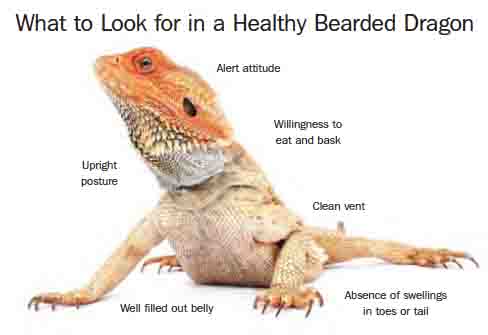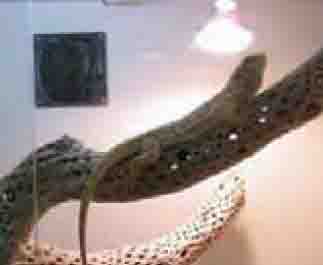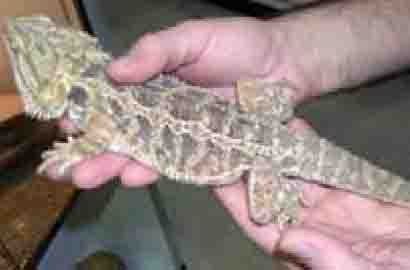| Adult
Length |
18 - 22 inches (45cm - 56 cm) |
| Avg.
Weight |
285 -510 g (10 - 18 oz) |
| Age
of sexual maturity |
1 to 2 yrs. |
| Length
at sexual maturity |
12 - 16 inches (30cm - 40cm) |
| Eggs
per clutch or grouping |
15 - 25, multiple clutches per
breeding season |
| Bearded
Dragon Life span |
10 to 15 years |
Source: Exotic DVM, Volume 8, Issue 5
 A pet bearded dragon does well in captivity and makes a good pet reptile. The name comes from the dark distended throat of the male. When purchasing, looks for these signs of good health. Have a Veterinarian check your lizard after purchase
A pet bearded dragon does well in captivity and makes a good pet reptile. The name comes from the dark distended throat of the male. When purchasing, looks for these signs of good health. Have a Veterinarian check your lizard after purchaseBearded Dragon Cages
A Pet Bearded Dragon requires a hot, dry or savanna like environment in a long and wide cage. It doesn't not have to be tall. The cage does require a secure screen top. Look for a 10 gallon to 15 gallon lizard terrarium for raising babies. As the lizard grows, a larger terrarium is required with the minimum floor space being 18 x 48 inches (46x122 cm). In gallons a bearded dragon terrarium should be at least 75 gallons or larger. We suggest keeping only 1 male per cage, but there can be 2 females. If 2 males are housed together, there can be dominance problems. Breeders often house 2 males together since this can stimulate reproduction.
 Pet Bearded Dragon Cage
Pet Bearded Dragon Cage
Source: Exotic DVM
Substrate: A pet Bearded Dragon will ingest any substrate made of small particles. For this reason do not use these types of covering; reptile sand, cat litter, walnut shell, wood shavings, gravel or wood chips. Preferred substrates are newspaper, reptile carpet, alfalfa pellets, cypress mulch or sterile potting soil if it can be disposed of with every cage cleaning.
Decor and Furniture: Cages should include basking rocks that are glued down so that they cannot move and injure the lizard (use silicone to glue on place). The bearded dragon cage should include climbing branches and a hiding shelter. Plants that thrive in this type of arid environment includes sansevieria, aloe, palms, and cycads.
Hiding Box: A pet bearded dragon terrarium should contain a hiding box. Wood hiding boxes can be periodically soaked in water to improve humidity levels.
Lighting: Bearded Dragons require direct sunlight or UVB light (no less than 5% UVB on package) in order to properly metabolize calcium. Sunlight that passes through windows or Plexiglas do not provide the required UV light. Recommended brands include the fluorescent UV light ZooMed ReptiSun 5.0 or the Mercury vapor bulb based ZooMed PowerSun. Fluorescent UV light should be located 18 - 20 inches from the lizard. Change fluorescent bulbs every 6 months when the lizard is young, and 1x per year as an adult. If using a Mercury Vapor bulb, change the bulb every year.
Water: Provide a water pan that will allow the entire pet bearded dragon to soak at least 1 to 2 times per week. Unfortunately, the lizard will drop feces in the water, so be sure to clean daily and disinfect the water pan with bleach weekly. Some bearded dragons will not drink from a water dish. To hydrate these lizards, provide the soaking pan and rinse any greens with water just before feeding so that the lizard ingests the water droplets.
Humidity: Any Pet Bearded Dragon cage should be well ventilated with humidity at 40% to 60% RH). Note that sand or newspaper could decrease cage humidity. Keep burrows and hiding boxes more humid than the rest of the bearded dragon terrarium.
Temperature: A pet bearded dragon requires the following daytime and night time temperatures:
| Cool
End of Cage |
Basking
Area surface temperature |
|
| Daytime |
80F - 85F |
88F - 95F (43.3C - 51.6C) |
| Night |
70F - 75F |
Do not let temperatures fall below 70F. During the day, the best approach is a temperature gradient with the cool side at 80F, moving to the heated side at 95F.
How To Take Care Of A Bearded Dragon
Growth: Young Lizards require a good amount of food to fuel their growth. They are approximately 3 inches at birth. By the end of month 2 they will be twice the length. They will reach full size (1 to 2 feet) after a year.
Nails:The nails do need to be clipped. Cat claw trimmers are the best way to clip the nails. Do not clip too close to the foot. Bleeding can be stopped by applying corn starch. Nails should be clipped every few weeks.
Bearded Dragon Diet
A pet Bearded dragon is an omnivore when a juvenile, feeding primarily on crickets and greens. The adult bearded dragon diet is mostly herbivorous, with some insects. Do not feed lightening bugs to Bearded Dragons.
The fruits and plants listed below can be added as an occasional treat. All food should be provided in a shallow dish to avoid the lizard ingesting any cage substrate with the food. At first, feed small crickets such as pinhead crickets and tiny just molted worms. Over time, the food can be increased in size.
Crickets should be no larger than the space between the lizard's eyes. If large crickets are swallowed whole they can cause health problems such as partial paralysis, loss of motor control, inability to self-feed, and a tetanic seizure that can cause death. As a treat, feed the lizard other insects on occasion such as wax worms (fatty, poor source of nutrition), super worms, mealworms. Crickets and mealworms can be pre-fed or gut loaded to improve the nutritional value.
Hatchings are fed daily with small crickets, worms, flies and moths. Also provide some greens with a calcium and mineral supplement. Provide a vitamin supplement 1x per week.
For juveniles, dust insects before feeding with the calcium powder immediately before feeding the lizard.
Adult pet Bearded Dragon feeding should occur every 24 to 48 hours.
Pinkie mice can be fed to the bearded dragon after 4 months of age. Younger lizards are fed smaller, younger mice. Mice can be provided 1x per week.
Also feed your bearded dragon a salad of calcium rich greens, including:
- collard greens
- dandelion greens and flowers
- escarole
- endive
- grape leaves
- mustard greens
- turnip greens
- watercress
Vegetables can also be added to the the salad of Bearded Dragon food for additional vitamins:
- acorn squash
- red bell peppers
- green bell peppers
- butternut squash
- carrots
- green beans
- lentils, peas
- pumpkin
- snow peas
- sweet potatoes
- turnips
- winter squash
There are several fruits that can be used as a treat. Remove pits and seeds before feeding to your lizard.
- apples
- apricots
- bananas
- berries
- cantaloupe
- figs
- grapes
- mangoes
- oranges
- papayas
- peaches
- pears
- plums
- tomatoes
These plants can also be added for nutritional variety to Bearded Dragon food:
- Ficus benjamina
- geraniums
- hibiscus flowers
- hibiscus leaves
- pansies
- petunias
- pothos
- rose petals
- rose leaves
- snail vine
- violets
The following Bearded Dragon foods have either low nutritional value or if fed regularly could result in health issues:
Avoid or use the following sparingly in a Bearded Dragon diet since they contain high levels of calcium oxalate which can lead to metabolic bone disease:
- kale
- chard
- cabbage
Also use these sparingly since they contain goitrogens which decrease the bearded dragon thyroid function:
- spinach
- broccoli
- parsley
These foods have low nutritional value:
- corn
- cucumbers
- radishes
- sprouts
- zucchini
Bearded Dragon Supplements
Juveniles require a calcium supplement that does not contain phosphorus or vitamin D). Provide the Bearded Dragon supplement 3x per week. Also provide a reptile multivitamin 1x per month. Both can be sprinkled on the salad ingredients described above. Also dust any insects right before feeding.
Adults on a combination of leafy greens, gut loaded dusted insects and occasional pinkie mice should get a 1x per week calcium supplement and 1x per month multivitamin supplement.
Behavior
The Bearded Dragon communicates by moving the body. If you observe behaviors such as a bobbing head, flattened body or tail whipping, the lizard is communicating submission to you. Do not keep two males in the same cage. One male can be kept with two females.
Bearded Dragon Handling Instructions
Baby Bearded Dragons: Life by placing your finger under the shin and body. Babies will cling onto the finger. Then transfer to the hand with the Bearded Dragon pointed at the fingers. Don't hold to tightly. Trap by cupping the hand.
Adults: Carry by the body by scooping them up. Keep the head facing the fingers. Support the tail. Over time, the lizard will get used to handling. Always wear gloves to avoid scratching the skin on the rough lizard skin.
 Bearded Dragon handling involves supporting the lizards body and tail with the hand. Wash hands after handling
Bearded Dragon handling involves supporting the lizards body and tail with the hand. Wash hands after handling
Source: Exotic DVM
Bearded Dragon Health
Veterinary Care
Bring a Bearded Dragon to a veterinarian after buying the lizard and then every year. The vet will examine a feces sample at the annual visit to ensure the bearded dragons health and safety.
Signs Of Bearded Dragon Disease
- Depression
- Sunken eyes
- Poor body condition
- Weakness
- Appetite loss (can also be caused by changes in behavior or the seasons)
- Gastrointestinal disease (sign of parasites)
- Constipation
- Anorexia
- Fractures
Common Bearded Dragon Health Problems
The following are common Bearded Dragon Health issues. If you have a specific question, fill out the form on the bottom of this page and our veterinary adviser will answer it for free. For urgent questions, we suggest using this online veterinary service is that available 24 hours a day.
- Parasites: Bearded Dragons commonly come down with parasites such as pinworms, coccidia and flagellated protozoa. Parasites cause gastrointestinal issues such as changes to the feces.
- Impaction: This is where the gastrointestinal tract becomes blocked. The condition is treated by swabbing the lizards cloacal, or via rehydration, enemas or surgery.
- Nutritional Problems: The biggest health problem with a Pet Bearded Dragon is calcium deficiency. (called calcium metabolism disorders). Treatment for calcium deficiency includes oral or injected calcium supplements.
- Reproduction Problems: A veterinarian will check for any physical problems such as a malformed pelvic bone or over sized eggs.
- Bearded Dragon Eye Problems: Bearded Dragons commonly come down with conjunctivitis and an infection called blepharospasm. Foreign objects in the cage can also irritate the cornea. For eye infection or scratches, the eye can be cleaned with saline and then a topical antibiotic can be applied.
- Bearded Dragon Skin Problems: The skin can be affected by bacteria or fungal infections. Topical antiseptics are used for bacterial skin infections. Fungal infections are yellow in color and are referred to as "yellow fungus disease." Treatment for yellow fungus disease is not effective, with many Bearded Dragons failing to recover.
- Injury: Cuts, abrasions and burns are common. Fractures can also occur when a cage rock lands on the lizard. Trauma is treated based on severity.
- Behavior: Dominance problems are also common if two males are housed together. Signs of stress due to dominance include weight loss and a decline in condition.
Have a Lizard Related Question for our Vet? We Will Answer it for Free!
Do you need some pet lizard advice? Just ask a question and our Vet will answer it as soon as possible.
If your question is medical or behavior-related, please include information such as species, age, diet, habitat, and anything related to the medical history of your lizard.
Please upload a picture of your lizard, especially if you believe it will help the Veterinarian. Please know that we receive many questions and answer them on a first-come, first-served basis. If you need an immediate response, we suggest you use this online veterinary service that is available now to answer your questions.
Other questions answered by our Veterinarian
Click below to see questions from other visitors to this page...
What is wrong with this thing? Not rated yet
This lady has 5 lizards with no UVB and mites. Look at this Bearded dragon. I can’t even begin to explain all of this. It looks awful. What is wrong with …